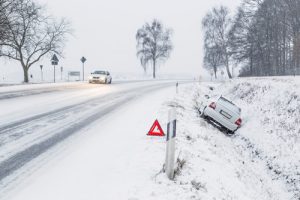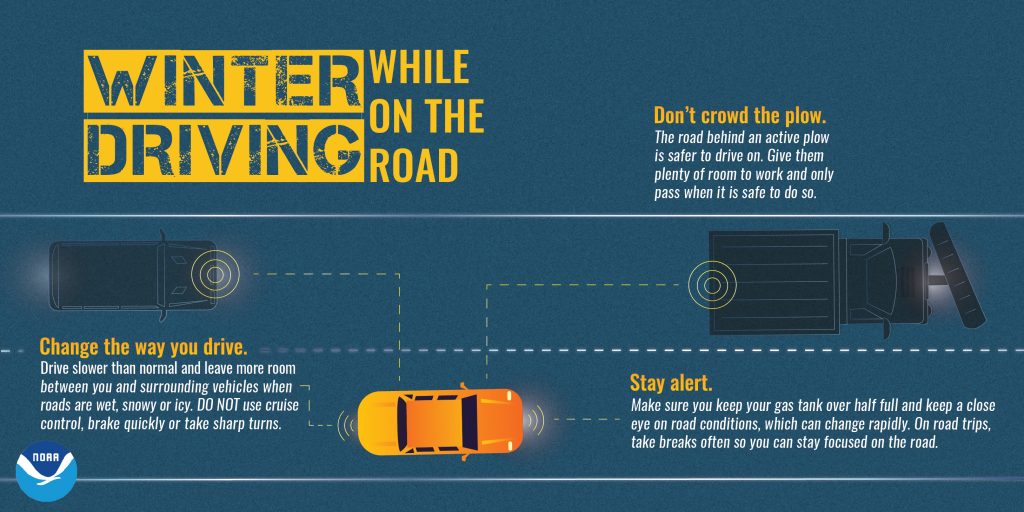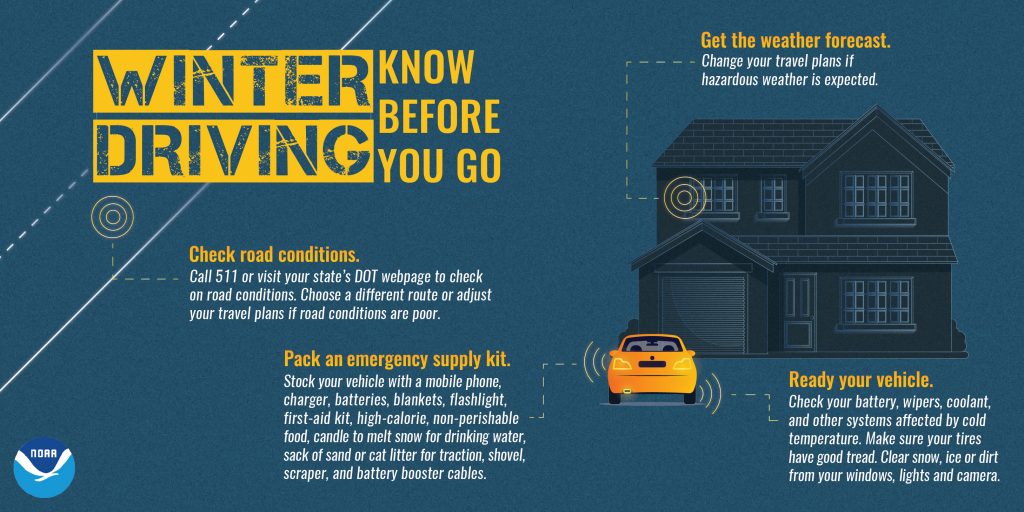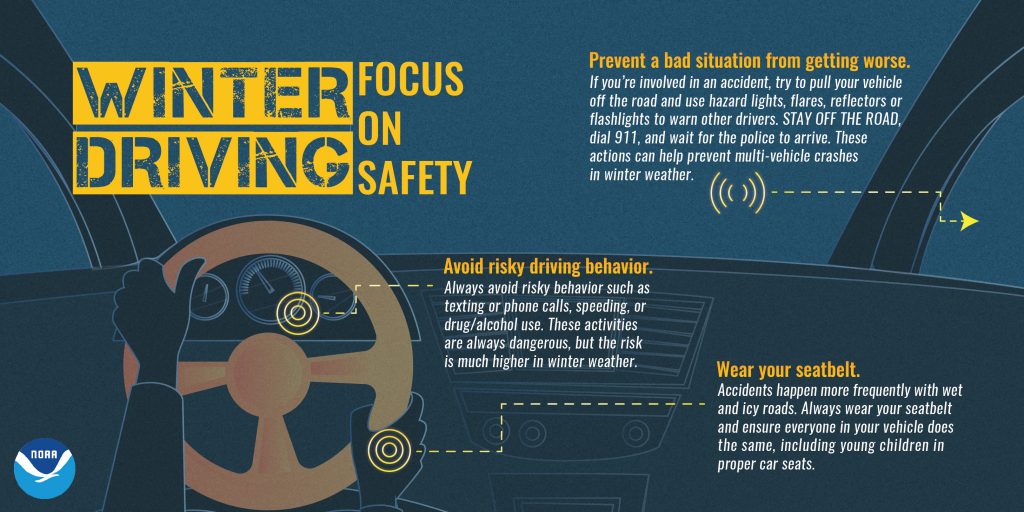Other Safety – Winter Weather Driving Tips

Learn about winter weather preparedness.
When driving in winter weather, watch out! Mother Nature has some tricks up her sleeve in the winter. Here are some to be on the lookout for:
- First Snow or Ice: Drivers often aren’t prepared for winter driving and forget to take it slow. Remember to drive well below the posted speed limit and leave plenty of room between cars.
- Limited Visibility: Stay attentive and reduce speed. Know what’s going on around you.
- Four-Wheel Drive: On snow and ice, go slowly, no matter what type of vehicle you drive. Even if you have an SUV with four-wheel drive, you may not be able to stop any faster, or maintain control any better, once you lose traction. Four-wheel drive may get you going faster, but it won’t help you stop sooner.
- Black Ice: Roads that seem dry may actually be slippery – and dangerous. Take it slow when approaching intersections, off-ramps, bridges, or shady areas – all are hot spots for black ice. Remember: Ice and Snow, Take it Slow.
Winter Driving Tips InfoGraphic PDF
Proceed with Caution!
- Speed: The faster you’re going, the longer it will take to stop. When accelerating on snow or ice, take it slow to avoid slipping or sliding. Ice and Snow Take it Slow.
- Distance: Give yourself space. It takes extra time and extra distance to bring your car to a stop on slick and snowy roads. Leave extra room between you and the vehicle in front of you.
- Brake: Brake early, brake slowly, brake correctly, and never slam on the brakes. If you have anti-lock brakes, press the pedal down firmly and hold it. If you don’t have anti-lock brakes, gently pump the pedal. Either way, give yourself plenty of room to stop.
- Control: When driving on ice and snow, do not use cruise control and avoid abrupt steering maneuvers. When merging into traffic, take it slow. Sudden movements can cause your vehicle to slide.
- Vision: Be aware of what’s going on well ahead of you. Other vehicles’ actions will alert you to problems more quickly and give you that split-second of extra time to react safely.
How to Drive on Black Ice
Prevent or minimize future encounters with black ice. There are several things that you can do to reduce the chances of being surprised by black ice. While knowing how to drive on it remains a number one priority, here are some other things to do:
- Travel slowly. Don’t try to speed during icy weather, as this will take away any control you might have had on the black ice.
- Adjust your speed to safely match weather conditions, road conditions, visibility, and traffic. You should reduce your speed by 1/3 on wet roads and by 1/2 or more on snow-packed roads (i.e., if you would normally be traveling at a speed of 60 mph on dry pavement, then on a wet road, you should reduce your speed to 40 mph, and on a snow-packed road you should reduce your speed to 30 mph).
- Don’t tailgate.
- Keep your windshield clear of ice, snow, dirt, and anything else that can prevent you from seeing out of it properly. To get snow and ice off the windshield of your car, you might be tempted to turn on your windshield wipers. It might seem like the wipers, and the washer fluid will work, but they don’t. In fact, if you use your windshield wipers to get ice off the windshield, you could ruin them. Use an ice scraper to scrape the ice from the windshield of your car before starting the vehicle.
- Turn your headlights on early in the afternoon to help you see any possible sheen from black ice.
- Check your tire tread. Worn tread causes accidents in any conditions and will ensure you lack traction when needed on black ice. Also, consider having snow tires fitted.
- NEVER drive in potentially icy conditions with your cruise control active.
More Tips
- If you have ABS brakes, know how they feel when they engage, so you don’t panic and that you understand what denotes slippery conditions– even if your car is still in control.
- Walking and cycling on black ice is also dangerous and can cause you to slip. Cyclists need to take extra care as slipping can lead you into the pathway of car and truck traffic.
- Have snow tires fitted before the temperatures drop low enough to cause black ice. This is especially important if you’re traveling outside your urban areas or not familiar with the roads and weather conditions.
- Stay off the phone, and don’t mess with the radio. Pay attention to the road, or you might wreck!
- A good tip for any ice driving is to avoid sudden movements. Quickly turning your tires, accelerating or braking can cause you to lose traction. One way to adapt your driving style to winter travel is to imagine an egg between your foot and the gas and brake pedals. Make it a priority to keep the imaginary egg intact. You’ll find yourself driving more cautiously in no time.
- If the weather is bad and the conditions are likely to result in black ice, try to stay home and avoid driving at all.
Winter driving with ice and snow can be hazardous. Additional preparations can help make a trip safer and/or help motorists better deal with an emergency.
Prepare:
Maintain Your Car:
- Check battery
- tire tread
- windshield wipers
- keep your windows clear
- put no-freeze fluid in the washer reservoir
- check your antifreeze levels
Have On Hand:
- flashlight
- jumper cables
- abrasive material (sand, kitty litter, even floor mats)
- shovel
- snow brush and ice scraper
- warning devices (like flares)
- for long trips, add food and water, medication, and cell phone.
Stopped or Stalled?
- Stay in your car
- don’t overexert
- put bright markers on antenna or windows
- shine dome light
- if you run your car, clear the exhaust pipe and run it just enough to stay warm
Plan Your route:
- Allow plenty of time (check the weather and leave early if necessary)
- be familiar with the maps/ directions
- let others know your route and arrival time.
Practice Cold Weather Driving
- During the daylight, rehearse maneuvers slowly on ice or snow in an empty lot.
- Steer into a skid.
- Know what your brakes will do: stomp on antilock brakes, pump on non-antilock brakes.
- Stopping distances are longer on water-covered ice and ice.
- Don’t idle for a long time with the windows up or in an enclosed space.
Driving in Winter Conditions
- Drive slowly. It’s harder to control or stop your vehicle on a slick or snow-covered surface. On the road, increase your following distance enough so that you’ll have plenty of time to stop for vehicles ahead of you.
- Know whether your vehicle has an antilock brake system and learn how to use it properly. Antilock brake systems prevent your wheels from locking up during braking. If you have antilock brakes, apply firm, continuous pressure to the brake pedal. If you don’t have antilock brakes, you may need to pump your brakes if you feel your wheels starting to lock up.
Navigating Around Snow Plows
- Don’t crowd a snowplow or travel beside it. Snowplows travel slowly, make wide turns, stop often, overlap lanes, and frequently exit the road.
- The road behind an active snow plow is safer to drive on. If you find yourself behind a snowplow, stay behind it, or use caution when passing.
- When you are driving behind a snowplow, don’t follow or stop too closely. A snowplow operator’s field-of-vision is limited; if you can’t see the mirrors, the driver can’t see you. Also, materials used to de-ice the road could hit your vehicle.
- Snowplows can throw up a cloud of snow that can reduce your visibility to zero in less time than you can react. Never drive into a snow cloud – it can conceal vehicles or hazards.
What to Do in a Winter Emergency
If you are stopped or stalled in wintry weather, follow these safety rules:
- Stay with your car and don’t overexert yourself.
- Put bright markers on the antenna or windows and keep the interior dome light turned on.
- To avoid asphyxiation from carbon monoxide poisoning, don’t run your car for long periods of time with the windows up or in an enclosed space. If you must run your vehicle, clear the exhaust pipe of any snow and run it only sporadically — just long enough to stay warm.
Know Your Car
Every vehicle handles differently; this is particularly true when driving on wet, icy, or snowy roads. Take time now to learn how your vehicle handles under winter weather driving conditions.
- Before driving your vehicle, clean snow, ice, or dirt from the windows, the forward sensors, headlights, taillights, backup camera, and other sensors around the vehicle.
- When your area gets snow, practice driving on snow-covered or icy roads—but not on a main road. Sharpen your winter weather driving skills and know-how your vehicle handles snowy conditions by practicing in an empty parking lot. See your vehicle’s manual to familiarize yourself with your vehicle’s features—such as antilock brakes and electronic stability control—and how the features perform in slippery conditions. For example, your vehicle or pedals may pulsate when controlling traction.
- For electric and hybrid-electric vehicles, minimize the drain on the battery. If the vehicle has a thermal heating pack for the battery, plug your vehicle in whenever it’s not in use. Preheat the passenger compartment before you unplug your vehicle in the morning.
- When renting a car, become familiar with the vehicle before driving it off the lot. Know the location of the hazard lights switch in case of emergency and review the owner’s manual so that you’re prepared for any driving situation that may arise.
Stock Your Vehicle
- Carry items in your vehicle to handle common winter driving-related tasks, such as cleaning off your windshield, as well as any supplies you might need in an emergency. Keep the following in your vehicle:
- Snow shovel, broom, and ice scraper.
- Abrasive material such as sand or kitty litter, in case your vehicle gets stuck in the snow.
- Jumper cables, flashlights, and warning devices such as flares and emergency markers.
- Blankets for protection from the cold.
- A cell phone with charger, water, food, and any necessary medicine (for longer trips or when driving in lightly populated areas).
Plan Your Travel and Route
- Keep yourself and others safe by planning before you venture out into bad weather.
- Check the weather, road conditions, and traffic.
- Don’t rush; allow plenty of time to get to your destination safely. Plan to leave early if necessary.
- Familiarize yourself with directions and maps before you go, even if you use a GPS, and let others know your route and anticipated arrival time.
Vehicle Safety Checklist
Battery
When the temperature drops, battery power also drops. For gasoline and diesel engines, it takes more battery power to start your vehicle in cold weather. For electric and hybrid electric vehicles, the driving range is reduced when the battery is cold, and battery systems work better after they warm-up. Make sure your battery is up to the challenges of winter.
- Have your mechanic check your battery for sufficient voltage, amperage, and reserve capacity.
- Have the charging system and belts inspected.
- Replace the battery or make necessary system repairs, including simple things like tightening the battery cable connections.
- Keep gasoline in a hybrid-electric vehicle to support the gasoline engine.
Lights
See and be seen! Make sure all the lights on your vehicle are in working order. Check your headlights, brake lights, turn signals, emergency flashers, and interior lights. Towing a trailer? Be sure to check your trailer brake lights and turn signals. Trailer light connection failure is a common problem and a serious safety hazard.
Cooling System
- Make sure the cooling system is in proper working order.
- Make sure you have enough coolant in your vehicle, and the coolant meets the manufacturer’s specifications. See your vehicle owner’s manual for specific recommendations on coolant.
- Thoroughly check the cooling system for leaks or have your mechanic do it for you.
- Have the coolant tested for proper mix, proper pH (acidity), and strength of the built-in corrosion inhibitors. Over time, the rust inhibitors in antifreeze break down and become ineffective.
- Drain and replace the coolant in your vehicle as recommended by the manufacturer, to remove dirt and rust particles that can clog the cooling system and cause it to fail.
Windshield:
Washer Reservoir
You can go through a lot of windshield wiper fluid fairly quickly in a single snowstorm, so be prepared for whatever might come your way—Fill your vehicle’s reservoir before the first snow hits.
- Use high-quality “winter” fluid with de-icer and keep extra in your vehicle.
Wipers and Defrosters
Safe winter driving depends on achieving and maintaining the best visibility possible.
- Make sure your windshield wipers work; replace worn blades.
- Consider installing heavy-duty winter wipers if you live in an area that gets a lot of snow and ice.
- Check to see that your front and rear window defrosters work properly.
Floor Mats
Improperly installed floor mats in your vehicle may interfere with the accelerator or brake pedal’s operation, increasing the risk of a crash.
- Remove old floor mats before installing new mats; never stack mats.
- Use mats that are the correct size and fit for your vehicle.
- Be sure to follow the manufacturer’s instructions for mat installation. Use available retention clips to secure the mat and prevent it from sliding forward.
- Every time the mats are removed for any reason, verify that the driver’s mat is reinstalled correctly.
Tires
- If you plan to use snow tires, have them installed in the fall, so you are prepared before it snows. Check out nhtsa.gov/tires for tire ratings before buying new ones, and look for winter tires with the snowflake symbol.
- Regardless of the season, inspect your tires at least once a month and before long road trips. It only takes about five minutes. If you find yourself driving under less-than-optimal road conditions this winter, you’ll be glad you took the time. Don’t forget to check your spare tire.
- As the outside temperature drops, so does tire inflation pressure. Ensure each tire is filled to the vehicle manufacturer’s recommended inflation pressure, which is listed in your owner’s manual and on a placard located on the driver’s side door frame. The correct pressure is NOT the number listed on the tire. Be sure to check tires when they are cold, which means the car hasn’t been driven for at least 3 hours.
- Look closely at your tread and replace tires that have uneven wear or insufficient tread. Tread should be at least 2/32 of an inch or greater on all tires.
- Check the age of each tire. Some vehicle manufacturers recommend that tires be replaced every six years regardless of use, but check your owner’s manual to find out.
- For more information on tire safety, visit NHTSA’s Tires page.
Warnings
- 4×4 vehicles, SUVs, vans, trucks, and large pickups have a high center of gravity. They are inherently unstable so that an ice slide followed by suddenly gripping the road can easily cause the vehicle to rollover. You do not want this to happen. Slow down.
- Never use cruise control in snowy or icy conditions. Be in full control of your vehicle at all times.
- If you are confused about front versus the rear in skidding: “If you see the front end of your car turning left or right, make a very gentle turn of the steering wheel in the ‘opposite’ direction.” That is the same as: “If you feel the back end of your car sliding left or right, make a very gentle turn of the steering wheel in the ‘same’ direction (that the rear is skidding).”
- Remember that zero percent traction is still zero percent traction. Even if you have an all-wheel drive, 4-wheel drive, or an SUV, once you lose traction, the car itself won’t help you. Drive safely and cautiously, no matter what type of vehicle you are driving.



Resources:
Winter Weather Safety Presentation: https://www.weather.gov/media/wrn/presentations/winter_2018_presentation.pdf
Sources:
https://www.fs.usda.gov/Internet/FSE_DOCUMENTS/fseprd488148.pdf
https://www.fmcsa.dot.gov/safety/driver-safety/cmv-driving-tips-too-fast-conditions
https://www.osha.gov/Publications/SafeDriving.pdf
https://www.fmcsa.dot.gov/safety/driver-safety/cmv-driving-tips-too-fast-conditions
https://www.fmcsa.dot.gov/safety/driver-safety/cmv-driving-tips-references#R16
http://www.dmv.state.va.us/webdoc/pdf/dmv60.pdf
https://www.in.gov/indot/2439.htm
https://www.weather.gov/wrn/infographics_winter




